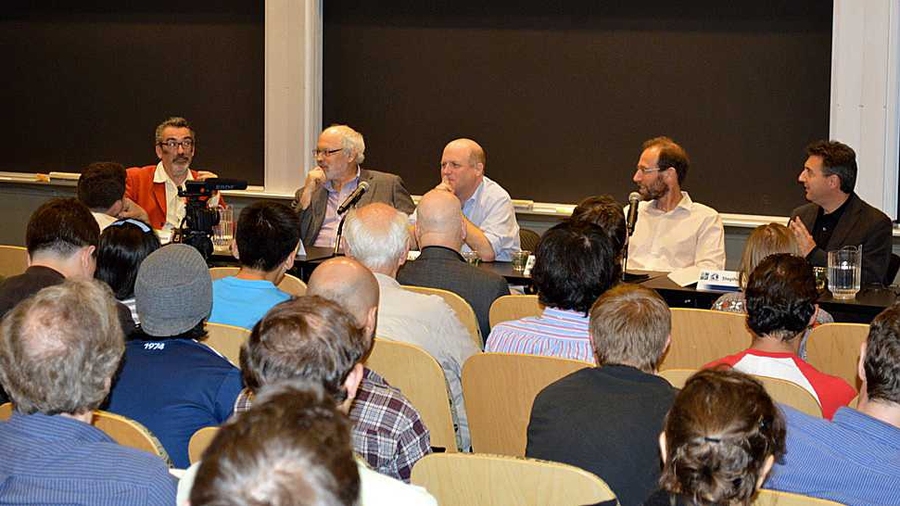At “Debating the Future of Solar Geoengineering,” a debate hosted last week by the MIT Joint Program on the Science and Policy of Global Change, four leading thinkers in geoengineering laid out their perspectives on doctoring our atmosphere to prevent climate change.
The debate featured Stephen Gardiner of the University of Washington, David Keith and Daniel Schrag of Harvard University, and Alan Robock of Rutgers University. Oliver Morton from The Economist ran the show as a deft and witty moderator.
The debate focused on the easiest, fastest and cheapest geoengineering option on the table: solar radiation management. This technique would involve intentionally injecting sulfate aerosols into Earth’s upper atmosphere, the stratosphere. These aerosols, which are the same particles released by volcanic eruptions, would reflect sunlight away from Earth, cool the planet, and, in theory, stabilize climate.
While climate modeling shows that solar radiation management would reduce risks for some people, there are a number of reasons why this technique might be a bad idea, Robock said. For instance, pumping particles into the stratosphere could shift rainfall patterns and chew up the ozone layer, thus tinkering with the amount of water and UV light reaching human and ecological systems. “We are going to put the entire fate of the only planet we know that can sustain life on this one technical intervention that may go wrong?” he challenged.
Robock’s stance is what Keith called “the very common, intuitive, and healthy reaction that geoengineering is ‘nuts’ and we should just get on with cutting emissions.” But Keith and Shrag systematically picked the argument apart as they made the case that, even in the most optimistic of scenarios, we may not be able to solve the climate problem by acting on greenhouse gas emissions alone. For them, geoengineering is a real option.
Humans are burning enough fossil fuels to put 36 billion tons of CO2 into the air every year. And because the gas stays in the atmosphere for incredibly long time periods, we’re already committed to global warming far into the future. “Climate is going to get a lot worse before it gets better,” Shrag said. “We have to push for emissions reductions, but the world is going to put a lot more CO2 in the atmosphere, and we better figure out what to do about it.”
But solar radiation management, Keith and Gardiner agreed, would not be ethical in the absence of a simultaneous reduction in CO2 emissions. As computer simulations by University of Washington researchers indicate, if we were to inject aerosols for a time, while continuing to emit CO2 as usual, a sudden cessation of the technique for any reason would be disastrous. The aerosols would quickly fall to natural levels, and the planet would warm at a pace far too rapid for humans, ecosystems and crops to adapt.
“So if, as a result of decisions to implement solar engineering to reduce risks now, we do less to cut emissions and emit more than we otherwise would, then we are morally responsible for passing risk on to future generations,” said Keith.
Caveats to geoengineering continued to roll in during the debate’s Q&A session. The technique would likely end up a dangerous catch-22 in the real world, according to Kyle Armour, a postdoc in MIT’s Department of Earth, Atmospheric and Planetary Sciences: “The case can be made that the times we would be most likely to use solar radiation management, such as in a climate emergency, are precisely the times when it would be most dangerous to do so.” In essence, implementing geoengineering to tackle an unforeseen environmental disaster would entail a rushed response to a misunderstood climate system with uncertain technology.
The post-debate reception was abuzz with conversations about the issue. Several MIT graduate students noted that the debaters never touched upon the most fundamental research needed to evaluate the viability of geoengineering: aerosol effects on clouds.
Aerosols in the stratosphere do reflect sunlight and exert a cooling effect on Earth. “But they have to go somewhere,” said MIT’s Dan Cziczo, an associate professor of atmospheric chemistry who studies how aerosols, clouds and solar radiation interact in Earth’s atmosphere. “Particles fall down into the troposphere where they can have many other effects on cloud formation, which have not been sorted out. They could cancel out any cooling we achieve, cool more than we anticipate, or even create warming.”
Indeed, the most recent Intergovernmental Panel on Climate Change (IPCC) report lists aerosol effects on clouds as the largest uncertainty in the climate system. “I don’t understand why you would attempt to undo the highly certain warming effect of greenhouse gases with the thing we are the least certain about,” Cziczo said.
The panelists acknowledged that scientists don’t understand the technique’s potential effects well enough to geoengineer today — but they have no plans to give up hope. Keith noted a need for a memorandum laying out principles of transparency and risk-assessment, as well as vastly expanded research programs for geoengineering. “Before we go full scale,” Keith said, as the debate came to a close, “we have to broaden far beyond the small clique of today’s geoengineering thinkers, but that doesn’t have to take decades.”
The debate featured Stephen Gardiner of the University of Washington, David Keith and Daniel Schrag of Harvard University, and Alan Robock of Rutgers University. Oliver Morton from The Economist ran the show as a deft and witty moderator.
The debate focused on the easiest, fastest and cheapest geoengineering option on the table: solar radiation management. This technique would involve intentionally injecting sulfate aerosols into Earth’s upper atmosphere, the stratosphere. These aerosols, which are the same particles released by volcanic eruptions, would reflect sunlight away from Earth, cool the planet, and, in theory, stabilize climate.
While climate modeling shows that solar radiation management would reduce risks for some people, there are a number of reasons why this technique might be a bad idea, Robock said. For instance, pumping particles into the stratosphere could shift rainfall patterns and chew up the ozone layer, thus tinkering with the amount of water and UV light reaching human and ecological systems. “We are going to put the entire fate of the only planet we know that can sustain life on this one technical intervention that may go wrong?” he challenged.
Robock’s stance is what Keith called “the very common, intuitive, and healthy reaction that geoengineering is ‘nuts’ and we should just get on with cutting emissions.” But Keith and Shrag systematically picked the argument apart as they made the case that, even in the most optimistic of scenarios, we may not be able to solve the climate problem by acting on greenhouse gas emissions alone. For them, geoengineering is a real option.
Humans are burning enough fossil fuels to put 36 billion tons of CO2 into the air every year. And because the gas stays in the atmosphere for incredibly long time periods, we’re already committed to global warming far into the future. “Climate is going to get a lot worse before it gets better,” Shrag said. “We have to push for emissions reductions, but the world is going to put a lot more CO2 in the atmosphere, and we better figure out what to do about it.”
But solar radiation management, Keith and Gardiner agreed, would not be ethical in the absence of a simultaneous reduction in CO2 emissions. As computer simulations by University of Washington researchers indicate, if we were to inject aerosols for a time, while continuing to emit CO2 as usual, a sudden cessation of the technique for any reason would be disastrous. The aerosols would quickly fall to natural levels, and the planet would warm at a pace far too rapid for humans, ecosystems and crops to adapt.
“So if, as a result of decisions to implement solar engineering to reduce risks now, we do less to cut emissions and emit more than we otherwise would, then we are morally responsible for passing risk on to future generations,” said Keith.
Caveats to geoengineering continued to roll in during the debate’s Q&A session. The technique would likely end up a dangerous catch-22 in the real world, according to Kyle Armour, a postdoc in MIT’s Department of Earth, Atmospheric and Planetary Sciences: “The case can be made that the times we would be most likely to use solar radiation management, such as in a climate emergency, are precisely the times when it would be most dangerous to do so.” In essence, implementing geoengineering to tackle an unforeseen environmental disaster would entail a rushed response to a misunderstood climate system with uncertain technology.
The post-debate reception was abuzz with conversations about the issue. Several MIT graduate students noted that the debaters never touched upon the most fundamental research needed to evaluate the viability of geoengineering: aerosol effects on clouds.
Aerosols in the stratosphere do reflect sunlight and exert a cooling effect on Earth. “But they have to go somewhere,” said MIT’s Dan Cziczo, an associate professor of atmospheric chemistry who studies how aerosols, clouds and solar radiation interact in Earth’s atmosphere. “Particles fall down into the troposphere where they can have many other effects on cloud formation, which have not been sorted out. They could cancel out any cooling we achieve, cool more than we anticipate, or even create warming.”
Indeed, the most recent Intergovernmental Panel on Climate Change (IPCC) report lists aerosol effects on clouds as the largest uncertainty in the climate system. “I don’t understand why you would attempt to undo the highly certain warming effect of greenhouse gases with the thing we are the least certain about,” Cziczo said.
The panelists acknowledged that scientists don’t understand the technique’s potential effects well enough to geoengineer today — but they have no plans to give up hope. Keith noted a need for a memorandum laying out principles of transparency and risk-assessment, as well as vastly expanded research programs for geoengineering. “Before we go full scale,” Keith said, as the debate came to a close, “we have to broaden far beyond the small clique of today’s geoengineering thinkers, but that doesn’t have to take decades.”







